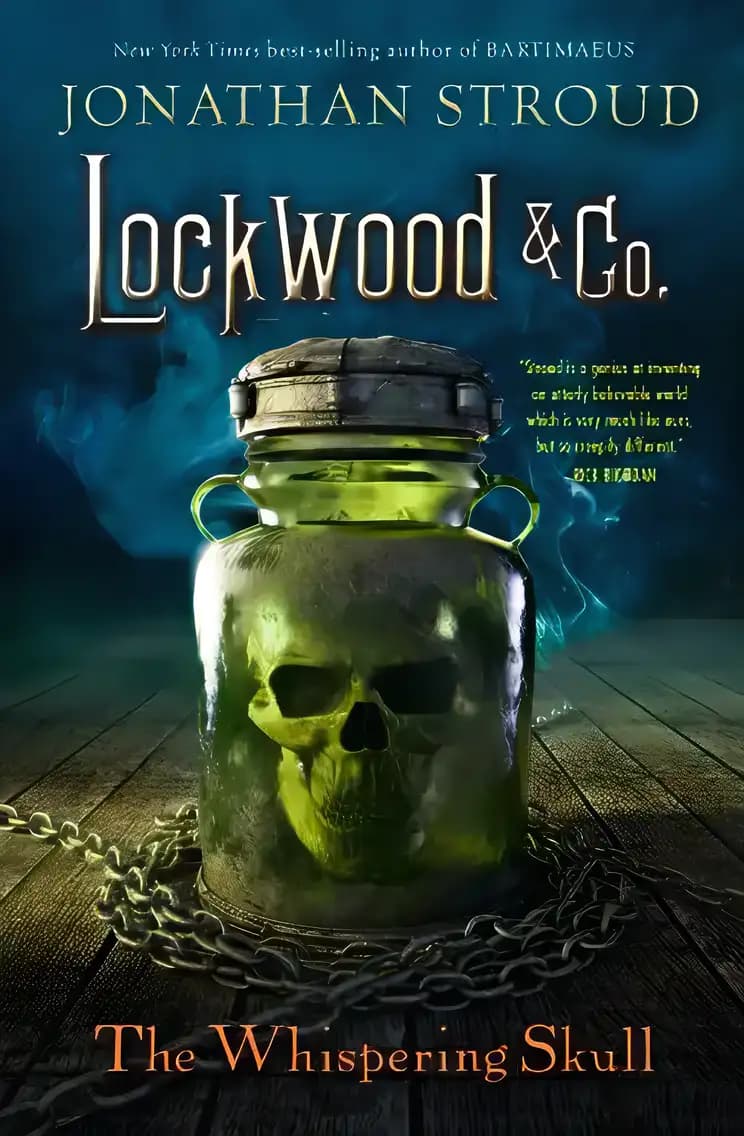The Whispering Skull
#2 of 5 in Lockwood & Co. Series
on Goodreads (40,393)
What’s inside...
In the six months since Anthony, Lucy, and George survived a night in the most haunted house in England, Lockwood & Co. hasn't made much progress. Quill Kipps and his team of Fittes agents keep swooping in on Lockwood's investigations. Finally, in a fit of anger, Anthony challenges his rival to a contest: the next time the two agencies compete on a job, the losing side will have to admit defeat in the Times newspaper. Things look up when a new client, Mr. Saunders, hires Lockwood & Co. to be present at the excavation of Edmund Bickerstaff, a Victorian doctor who reportedly tried to communicate with the dead. Saunders needs the coffin sealed with silver to prevent any supernatural trouble. All goes well until George's curiosity attracts a horrible phantom. Back home at Portland Row, Lockwood accuses George of making too many careless mistakes. Lucy is distracted by urgent whispers coming from the skull in the ghost jar. Then the team is summoned to DEPRAC headquarters. Kipps is there too, much to Lockwood's annoyance. Bickerstaff's coffin was raided and a strange glass object buried with the corpse has vanished. Inspector Barnes believes the relic to be highly dangerous, and he wants it found.
Character compass
Lucy Carlyle
Anthony Lockwood
George Cubbins
Quill Kipps
John Joplin
The Whispering Skull
Discussion points
Why do you think the skull whispers, and what effect does it have on the characters?
How do the different characters react to challenges? What does that tell us about them?
What role do friendship and trust play in this story?
If you had a supernatural ability like the characters, how would you use it to help others?
What is the importance of understanding history in the book? How does it impact the characters' decisions?
Tip: Role play these questions
Highlight key moments in the book where characters face moral dilemmas and discuss the possible choices they could make.
Encourage your child to compare the characters’ reactions to their own potential reactions in similar situations, fostering empathy and self-awareness.
Discuss the historical elements woven into the story to enhance your child's interest and understanding of the narrative's context.
Use examples from the book to talk about the importance of teamwork and how combining diverse skills can lead to success.
Key lessons
Example Lesson: Teamwork and Collaboration
Explanation: In 'The Whispering Skull,' the characters must work together to solve supernatural mysteries, demonstrating the power of teamwork.
Real-World Application: Children can learn the importance of collaborating with others to achieve common goals, whether in group projects at school or in team sports.
Example Lesson: Responsibility and Accountability
Explanation: The young protagonists in the book are responsible for managing a ghost-hunting agency, showing readers how taking responsibility leads to personal growth.
Real-World Application: This encourages children to take responsibility for their actions and tasks, be it in completing homework or chores at home.
Example Lesson: Courage in the Face of Fear
Explanation: The characters often face frightening situations but find the courage to confront and overcome them.
Real-World Application: This can inspire children to face their fears, whether it’s speaking in front of the class, trying out for a sports team, or dealing with a difficult situation at home.
Example Lesson: Importance of Knowledge and Learning
Explanation: The book highlights how knowledge about the supernatural elements is crucial for the characters' success in their ghost-hunting endeavors.
Real-World Application: Children are encouraged to value education and see how gaining knowledge can help solve real-life problems.
Example Lesson: Ethical Decision Making
Explanation: Characters in the story frequently face moral dilemmas that require them to choose between right and wrong.
Real-World Application: This lesson teaches children the importance of making ethical decisions and considering the consequences of their actions in everyday life.
